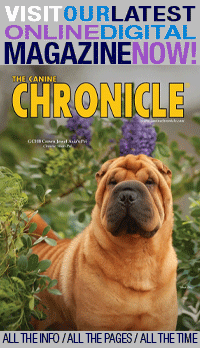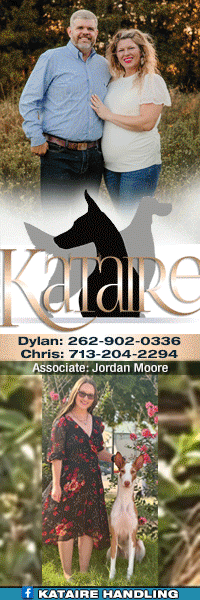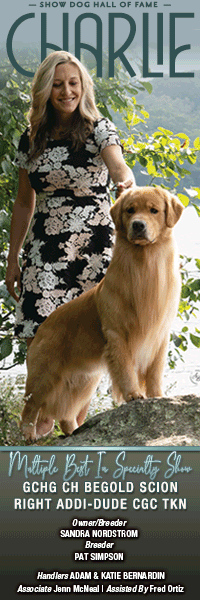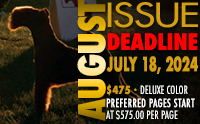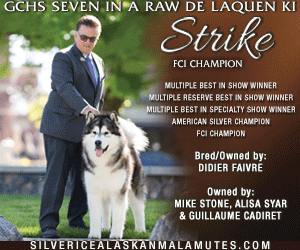Hounds – Toplines & Underlines
 by Lisa Dubé Forman
by Lisa Dubé Forman
It is elementary that shape, others prefer the word silhouette, nearly always defines breed type in our hounds. My intent is not to cover each of the hound group’s 27 breeds. Rather, I have highlighted breeds to illustrate essential elements of shape. The hound group species are diversified into sight and scenthounds and within the sighthound classification, a more specific genre exists being the Greyhound and greyhound-like breeds. I will discuss this exclusive cast first as it is very important to me and, hereafter, I will usually refer to them as genre. The greyhound shape is prerequisite for the Scotch Deerhound, the Irish Wolfhound, Borzoi, Whippet, and Italian Greyhound. Hence, the topline is more than an isolated component, it is indistinguishable from type. This genre does not fit into the typical judges dialect of square or rectangular which is often used while studying unfamiliar breeds. Greyhound-like breeds are a series of flowing curves with length of limb, bone, frame and height, not low-to-the-ground rectangles or ‘cobby’ squares. The amalgamation of the length, shape and curvature of vertebrae of the spinal column conjointly with the hard, smooth muscling encapsulating, supporting the loin area create the characteristic, conspicuous and prominent arch over the loin. These, together with the great breadth across the loin and pelvis, the balanced length of the femur, (first thigh) and tibia (second thigh) enable the beautiful, greyhound-like topline. Most technical terms define topline as the point over the scapula blades (usually referred to as withers) with its thirteen thoracic vertebrae, continuing rearwards on the vertebral column and its seven lumbar vertebrae (loins) and over the three sacral vertebrae. A fluid greyhound-like topline begins on the plane of the skull, over the occiput and glides down over a powerful, arched, well-set neck with depth. It continues to flow over the shoulder, the anticlinal vertebrae and begins to rise gradually at this point past the seventh floating rib on and over arched loins of great breadth, carrying over the croup junction, descending along a broad, thirty degree sloped croup finally skimming down the tail. When made correctly, it is a thing of beauty as discernible in Figure 1 which illustrates a wolfhound retaining shape on the move who is superbly constructed and muscled. Absent are any sharp angles or abrupt stops, simply a fluent topline. As a learning tool for the uninitiated, I include three photos of this wolfhound at various ages to illustrate how she correctly retained shape. I have found that observing unfamiliar breeds in chronological stages is very helpful. Figure 3 was taken in her prime and shortly before her death from Osteosarcoma which had metastasized in her abdomen and eventually burst. One can observe the noticeable paunch in her belly, however, the metastasis at the time of this photo was unknown.
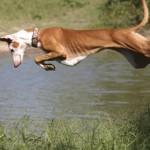 When applied to dogs, the principle of form ever follows function, is that the shape should be primarily based upon its intended function or purpose. Therefore, the greyhound-like shape with its prominent arch of loin, its series of flowing curves is the essence without which we would have another breed entirely. The underline is as equally important as the topline to this unique genre. These hounds must have ribs extending well-back. Short sternums, short-ribbing, usually result in a sharp cutup to the belly which not only is unattractive but is debilitating. A steep thorax and its shortcomings weaken, not empower these hunters, as the short-ribbed back and slab-sided hounds lose area for sizable heart and great lung capacity, diminishing stamina. Above all, a long rib cage is armor, shielding the hounds internal organs from harm as well as providing area volume for a strongly-muscled diaphragm which affects respiration.
When applied to dogs, the principle of form ever follows function, is that the shape should be primarily based upon its intended function or purpose. Therefore, the greyhound-like shape with its prominent arch of loin, its series of flowing curves is the essence without which we would have another breed entirely. The underline is as equally important as the topline to this unique genre. These hounds must have ribs extending well-back. Short sternums, short-ribbing, usually result in a sharp cutup to the belly which not only is unattractive but is debilitating. A steep thorax and its shortcomings weaken, not empower these hunters, as the short-ribbed back and slab-sided hounds lose area for sizable heart and great lung capacity, diminishing stamina. Above all, a long rib cage is armor, shielding the hounds internal organs from harm as well as providing area volume for a strongly-muscled diaphragm which affects respiration.
This is a natural transition point to discuss several disturbing trends. There are a noticeable number of greyhound-like specimens with significantly flatter to near straight toplines insofar as they lack a well-arched or even slightly arched loin. We also have come across a number with ‘ski-sloped’ toplines. These should be seriously penalized as they are not minor faults, nor harmless, but deleteriously affect the hounds functionality and are an antithesis to the greyhound and those of that sort. This genre should not have the appearance of an Ibizan Hound topline, nor should the greyhound, wolfhound and deerhound resemble the Ibizan in his slightly, off-square shape. Here I expound on the observed parallels that are supposed to be incompatible. The Podencos Ibicencos or Ibizan Hound, is a hound whom I hold in great admiration as their shape permits them to fulfill their function with such great joie de vivre. Their form ideally derives from their function and it is evident–elementary–why they are shaped in this fashion. The correct Ibizan has a straight back with a slight arch over the loin. This is ideal for his hunting terrain and how he performs on the hunt, but is the obverse of how a greyhound-like breed should be constructed and envisaged. Figure 4 illustrates lovely Ibizan topline and shape, yet we see the same in our greyhound genre today. The Ibizan Hound has a long, slender, slightly arched and strong, yet flat muscled neck. The topline, from ears to tail, is smooth and flowing, the back is level and straight. The loin is very slightly arched, with a croup that slopes very slightly, the hound is slightly longer than tall and its’ primary quarry is rabbits. The operative wording is that the Ibizan is slightly longer than tall. The back is straight with a very slightly arched loin. Their shape is one of the components that allow the Ibizan to fold mid-air and change direction as seen in Figure 5, and to jump upwards of six feet from a complete standstill. The Ibizan hunts in its own unique fashion by standing vertically on his hind legs to listen and look into bush (see Figure 6) and is capable of completing fantastic mid-air leaps as seen in Figure 7. The Ibizan photos portray achievements of a tremendous athlete who is slightly off-square, whose topline is straight-backed and has only a very slightly arched loin. For the motivated, there are many educational videos of the Ibizan hunting which will leave the viewer with a clearer appreciation for this hounds unique configuration and capabilities.
Mrs. Nan Kilgore Little, who is quite a renowned figure in Ibizan Hounds, provides testimony on the Ibizan topline. “This is my description of the Ibizan Hound outline, the total silhouette of the dog at alert or in what is considered the show presentation pose. First of all, no handler can stack a dog as well as a good confident dog can stack itself. Handlers often have an annoying habit of pulling the dog out of position. Straightening the line of the neck and the shoulders, placing the rear so far back as to make the topline slope. Starting at the nose, it should protrude beyond the mouth. The Ibizan does not have a blunt muzzle. Following the line of the nose along the top of the muzzle it should be long, equal to the length of the backskull. Over the ridge of the muzzle there should be a slight Roman convex. Not extreme but noticeable, generally more in the dog than the bitch. The rise from muzzle to backskull should be a gently sloping, barely noticeable stop. A step up is very incorrect. The plain of the muzzle and the skull are parallel. The skull is long and flattened. There should be a point at the back, the occiput, this is not always seen, unfortunately. The occiput should make a point but not so extreme as in the Irish Setter. Set high on the head, with base at level with the eye are the crowning glory, the large rhomboid ears. Viewed from the side the ear arches forward slightly and then arches backwards slightly following the line of the neck. As you follow along the line of the neck there should be a slight crest to it. It is long and slightly arched. This smoothly flows into the raised withers. It should not come down at a right angle to the back. The withers flow down to the level back, the hand span between the withers and the loin. Then the topline gently rises over the loin. This has the muscles that facilitate the double suspension gallop. There has been some misunderstanding the entire topline should be level. Dogs in running condition generally have a more developed rise over the loin. Hip bones should be in evidence. The croup drops off at a fair angle. This aspect is being lost because of changes to the AKC standard calling for slight slope instead of sloping croup. The long low-set tail generally hangs when the dog is standing. This tail can be carried in many positions but on hunting must rise above the back but not lay upon the back. The point of the buttock, or ischium is pointed. This says two things: that the dog is fit and has proper flat muscle and that the angulation of the hip to the ischium to the stifle is properly angled. Too open of an angle, a problem seen in many breeds today will give nothing beyond the tail. As Rachel Paige Elliot stated, ‘The second thigh should be long and well-angled. Not extreme but enough to allow the Ibizan to gather itself for the glorious leaps.’ The old Spanish standards spoke of ‘well elbowed hocks, strong and close to the ground.’ A line from the point of the hip will drop to the point of the stifle. If the dog is standing properly, the line from the point of the hock to the back of the foot will be vertical. Following up the vertical line of the front of the lower leg to the front of the hock joint it should angle up to a well bent hock. Again if you go straight up from the point of the stifle you should come to the hip bone. The tuck-up of the Ibizan is pronounced but the chest should not be extremely deep. The long upper arm is well in front of the deepest part of the chest. This upper arm is more straight than in most other sighthounds, but not bolt upright being slightly under the forechest. The sternum forms a noticeable angle, but not a great sharp keel. The underside of the neck has a nice clean sweep, dry fleshed. So here we have made the trip around the total outline. A very unique outline, immediately setting the breed apart from any other.”
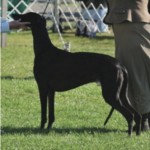 Many of the Ibizan breed characteristics cannot nor should not be applied to our large game killers. Figure 1 narrates a wolfhound’s correct shapely, fluid gait, rarely seen any longer. The question remains–why then are such toplines increasingly resembling an Ibizan Hound when they are to be greyhound-like galloping hounds? The wolfhound, deerhound and borzoi did not evolve for purposes of hunting hares in the perfect cover and terrain of bush, rocks, culverts and steep inclines. This worrisome departure from their standards also reveals another related, worrying and unattractive issue. I have observed many of these breeds, who in profile display a scintilla of shape, certainly not adequate, and when these hounds step off to move, they flatten out while gaiting. Many gait exhibiting nearly parallel toplines to the ground. In the most essential respects, they lower their neck so that the head, shoulders, back and loin are all on the same plane. The lack of a flowing, curvaceous topline and therefore, arched loin on the greyhound genre breeds is dysfunctional and is evidential of an inflexible topline. Simply it is a contradiction in terms. There may be a reader in disagreement as they proudly declare their greyhound genre hound is a lure coursing Field Champion who possesses a flatter to flat topline. I have great respect for a number of knowledgable acquaintances who are lure coursing enthusiasts and although they fully enjoy the pastime, these people will readily agree with me on the following. Unequivocally, a field champion title on either a wolfhound, deerhound, and borzoi galloping in lure competitions for typically 600 to 1000 yards chasing a lure (bag) dragged on the ground at varying speeds to simulate the escape pattern of a Hare is NOT corroboration of a flexible, large game, endurance hunter. Consequently, I disagree with those who place exaggerated emphasis on any prefix or succeeding title associated with the aforementioned breeds. These titles are not synonymous nor proof of stature or that of a powerful hunter who has the capacity to last and withstand enormous wear and tear. These three breeds evolved with varied purposes dictated by terrain and game they were to hunt, three to four hundred pound Red Deer, stags or wolves. The Scotch, as you will see shortly, is a formidable hunter of stag in steep inclines. Because of their shape and stature, they were known to be faster in the chase up the slopes than the stag. The hunting techniques of the borzoi, until the 1930s known as Russian Wolfhounds, originally were trained, after slipped, to course the Eurasian wolf, sometimes for miles, usually engaging them by hitting with their shoulder and holding the live wolf at bay until the hunters arrived. The wolfhound’s primary task was capturing, then killing the wolf. Here I include fascinating facts for the reader to understand the formidability of the Eurasian wolf, a foe with recorded heights of 30 or more inches and weights of 190 pounds, or 86 kilograms or more. From the comprehensive field study performed by Polly Brewster in Howl, One Writer Devotes Herself to the Survival of the American Gray Wolf, “Wolves can sprint 35 to 40 miles per hour through the snow. Wolves are built for hunting, their bodies perfectly designed for the takedown, with jaws capable of exerting more than 1,000 pounds of pressure per square inch with molars capable of crushing bone and whose canines can hold on to the nose of a moose running 35 miles per hour. They can bound 16 feet in deep snow—that’s like jumping the length of a station wagon.” As this article continues in upcoming parts, I include photographs and additional field study results on, indeed, such magnificent and dangerous game. In 1885, Captain George Augustus Graham wrote in his wolfhound essay, “Strength, stature and fleetness were the points most carefully cultivated — at any rate, as regards to those breeds used in the capture of large and fierce game.”
Many of the Ibizan breed characteristics cannot nor should not be applied to our large game killers. Figure 1 narrates a wolfhound’s correct shapely, fluid gait, rarely seen any longer. The question remains–why then are such toplines increasingly resembling an Ibizan Hound when they are to be greyhound-like galloping hounds? The wolfhound, deerhound and borzoi did not evolve for purposes of hunting hares in the perfect cover and terrain of bush, rocks, culverts and steep inclines. This worrisome departure from their standards also reveals another related, worrying and unattractive issue. I have observed many of these breeds, who in profile display a scintilla of shape, certainly not adequate, and when these hounds step off to move, they flatten out while gaiting. Many gait exhibiting nearly parallel toplines to the ground. In the most essential respects, they lower their neck so that the head, shoulders, back and loin are all on the same plane. The lack of a flowing, curvaceous topline and therefore, arched loin on the greyhound genre breeds is dysfunctional and is evidential of an inflexible topline. Simply it is a contradiction in terms. There may be a reader in disagreement as they proudly declare their greyhound genre hound is a lure coursing Field Champion who possesses a flatter to flat topline. I have great respect for a number of knowledgable acquaintances who are lure coursing enthusiasts and although they fully enjoy the pastime, these people will readily agree with me on the following. Unequivocally, a field champion title on either a wolfhound, deerhound, and borzoi galloping in lure competitions for typically 600 to 1000 yards chasing a lure (bag) dragged on the ground at varying speeds to simulate the escape pattern of a Hare is NOT corroboration of a flexible, large game, endurance hunter. Consequently, I disagree with those who place exaggerated emphasis on any prefix or succeeding title associated with the aforementioned breeds. These titles are not synonymous nor proof of stature or that of a powerful hunter who has the capacity to last and withstand enormous wear and tear. These three breeds evolved with varied purposes dictated by terrain and game they were to hunt, three to four hundred pound Red Deer, stags or wolves. The Scotch, as you will see shortly, is a formidable hunter of stag in steep inclines. Because of their shape and stature, they were known to be faster in the chase up the slopes than the stag. The hunting techniques of the borzoi, until the 1930s known as Russian Wolfhounds, originally were trained, after slipped, to course the Eurasian wolf, sometimes for miles, usually engaging them by hitting with their shoulder and holding the live wolf at bay until the hunters arrived. The wolfhound’s primary task was capturing, then killing the wolf. Here I include fascinating facts for the reader to understand the formidability of the Eurasian wolf, a foe with recorded heights of 30 or more inches and weights of 190 pounds, or 86 kilograms or more. From the comprehensive field study performed by Polly Brewster in Howl, One Writer Devotes Herself to the Survival of the American Gray Wolf, “Wolves can sprint 35 to 40 miles per hour through the snow. Wolves are built for hunting, their bodies perfectly designed for the takedown, with jaws capable of exerting more than 1,000 pounds of pressure per square inch with molars capable of crushing bone and whose canines can hold on to the nose of a moose running 35 miles per hour. They can bound 16 feet in deep snow—that’s like jumping the length of a station wagon.” As this article continues in upcoming parts, I include photographs and additional field study results on, indeed, such magnificent and dangerous game. In 1885, Captain George Augustus Graham wrote in his wolfhound essay, “Strength, stature and fleetness were the points most carefully cultivated — at any rate, as regards to those breeds used in the capture of large and fierce game.”
Since there is no question as to the necessary, consummate greyhound shape, we should delve into the fundamentals of the Greyhound himself, known in antiquity also as “Long-dog.” Contained within the glorious book, Greyhounds in America Volume 1, is an important quote. The authors state that in the fourteenth century, Edward Duke of York in The Mayster of Game provides what may be the first standard of the greyhound breed (translated from The Middle English). “Shoulders as a Roe Buck, the forelegs straight and round enough but not so the hind legs. The feet straight and round as a cat and with great claws. The bones and joints of the backbone as large and hard as the backbone of a harte. The thighs as large and squared as a hare, the hocks straight and not curving such as an ox.” This criterion is important as the Duke of York defines the bones and joints of the greyhound backbone (spinal column, ensuing topline) as large and hard as the backbone of a harte. “Harte,” is a Middle English reference to male Red Deer (stag or hart) indigenous to England. Thus, the description of the greyhound’s distinguishing features in the vertebral column are critical to prevent injury to the hunting “Long-dog.” I will pause here to rhetorically ponder out loud why fourteenth century fanciers, who selected canine stock carefully according to the dog’s function and performance, were exceptionally erudite, while it seems that present-day fanciers are not so learned. We logically could assume modern day fanciers should be even more knowledgeable since facts and information are so easily obtained by way of the information superhighway. More so, knowledge is facilitated by time well-spent with an excellent mentor and modern day travel is light years ahead of the fourteenth century. Perhaps this drift or deviation into flat toplines may be due to a number of people underestimating a topline’s value and purpose, or they do not understand what is nor how to breed a correct topline. Most likely they do not know where the vertebral column should begin its gradual ascent creating, with its length and shape of vertebrae along with muscling, the much needed arch of the loin–or how it fits into the croup junction. Essentially, they lack the rudimentary knowledge of the topline being an essential component in conveyance.
On this point, I will share the following greyhound briefing for enlightenment. Ms. Linda Bell, an eloquent and long-standing member of the greyhound community since the 1960s, provides expert commentary on the topline of the greyhound. Her contribution is of significant value to the uninitiated. “When you observe an ideal topline you will see a well laid shoulder flowing smoothly into a comparatively long ribcage [the back]; the arch of the loin commencing at the last rib forming a moderate keystone arch between the last rib and the pelvis. This arch is dependent on the angle of both the shoulders and the pelvis along with the length of the bones of the first and second thighs. These thigh bones should be of relatively the same length. Changes in any of these angles and lengths produce a variety of incorrect toplines, from overarched and inflexible to flat. The key to the arch is flexibility essential in the double suspension gallop allowing the dog to double up on the ground and straighten in midair. An extreme, inflexible topline severely limits the power of extension in the gallop. The ideal loin is broad, strong and deep aiding not only in speed but also in stability, this is very important as witnessed in the turn. In summation, perfection in balance and proportion equals the angle of shoulder to length of back, to arch of loin, to angle of pelvis, to length of first and second thigh.”
The Greyhound Club of America (GCA) has an outstanding booklet in which the former and current GCA Education Committee deserves continuous praise, The Greyhound, Form Follows Function, begins with the hindquarters and moves forward on the dog. I will not quote chapter and verse, however, I will provide various excerpts that are critical to that which Ms. Bell discussed. “In the structure of the greyhound, the segments of the dog are interconnected in such a way that the size and placement of each bone affects the entire structure and therefore the overall conformation of the dog. The four major parts of the hindquarters are the pelvic bone which determines the length and slope of the croup, the upper and second thigh which meet at the stifle, and the hock… The main lever for the rear driving action is the upper thigh. In order to maximize the thrust of the leg, this bone should be very long, appearing as the longest of the three leg bones. The second thigh adds to the length of the lever with a hinge at the stifle joint and the hock joint is the third hinge to bring additional thrust from the foot…If the upper thigh becomes shorter without the change in the length of the second thigh, the croup must become steeper and this shifts the angle of the spine, increasing the arch over the loin, generally extending it onto the back. Lengthen the second thigh and either the croup and the topline will flatten out, or it will be coupled with a very straight shoulder and upper arm assembly which increases the height of the dog to keep the topline basically level. Accompanying the long second thigh, we usually see a wide hock joint and often sickle hocks. There are many more variations possible, in general though, any alteration of one part of the rear structure will have an impact on the basic outline of the hound, particularly the topline, so it is important to have a good understanding of the correct topline. The loin is an essential part of the running dog as there must be sufficient length to allow flexing as the dog moves from the folded position to the extended position. The entire spine takes part in this motion with the head thrown back as the loin folds and thrusts down as the back flattens out. The raising and lowering of the head and neck augments the motion in the rest of the spine like waves flowing down a rope when it is moved up and down rapidly…In order to move in this manner, the spine must be flexible and very well-muscled.” These excerpts from the booklet along with Ms. Bell’s comments, speak comprehensively about the scope and action, the importance of and how to achieve a correct topline. Figure 8 illustrates a superb greyhound exuding shape in profile.
I continue with the Scotch Deerhound. Ms. Rusty Kingery, longstanding Deerhound fancier, member and Judges Education Chairperson for the Scottish Deerhound Club of America articulates the following summary on the Scotch hound’s topline. “The Scottish Deerhound standard describes it best and tells why. The loin well arched and drooping to the tail. A straight back is not desirable, this formation being unsuited for uphill work, and very unsightly. They were worked on the hilly and rough terrain of the Scottish Highlands to run down the Red Deer. They needed a very flexible spine to be able to tuck their powerful rear under them to get the power to bound up a slope. It was said that a good, fast Deerhound could go up a steep hill three or four yards for a deer’s one. Important—as on the down hill they were more evenly matched. We, as Breeders and hopefully those of you who become Judges, must be very careful to preserve the structure for ‘taking to the hills.” A correct Scotch Deerhound, with its very distinguished breed characteristics both in profile and in full, double suspension gallop, is a beauty to behold. Figure 9 depicts a Deerhound’s shapely, marvelous, flexible topline. In short, it is not necessary to expound anymore on the Scotch after the summary from Ms. Kingery and the excellent dissertation by the Greyhound experts.
Herein we review the Borzoi Hound as the other member of this genre. Mrs. Jan Leikam, longtime fancier of Borzoi contributed the following explanation and illustration in Figure 10. “The silhouette of a Borzoi is probably the most recognized characteristic of the breed due to the Art Deco movement which used this exaggerated feature in so many ways. However, the true Borzoi certainly does not have this trait but many people approach the topic of correct topline with trepidation and misunderstanding. The Borzoi was developed to hunt by sight and speed alongside the aristocracy on the open plains of Russia and, as such, needed much the same attributes as the Greyhound with added coat for winter survival. This is a man-made adaptation and still carries the longer loin and deep chest of successful running dogs who hunted many types of game from hares to wolves. His main gait is the double-suspension gallop and therefore exhibits the extreme tucked body followed by the extreme stretched position calling for flexibility of spine coupled with drive in the rear. Borzois should have a ‘rise’ over the loin which provides strength and flexibility for running. The back itself should be fairly short, but the ribcage should sweep back to protect the internal organs with the underline accentuating this. I believe the highest point should be in a line with the farthest sweep of the ribcage which will allow for a gradual slope of the loin area into the croup which to the eye extends and overstates the actual rise. If the rise is too far back the dog appears to ‘run downhill’ and the topline becomes swaybacked. The correctness of the topline gives structure to the entire dog, both standing and moving. The smoothness of the neck into the shoulder indicates the correct front assembly which allows the dog to run without breaking down on his front feet and pasterns. The short back allows the transfer of forward motion in an efficient manner with the long loin allowing agility and turning ability plus power. The slope of the croup allows the large thigh muscles to bunch and drive with the greatest power. Conditioning also affects toplines. Recalling Braxton Sawyer’s Foxhounds, “while in hunting condition, looked almost ‘roached’ in topline and when show season came along they got softer in muscling, and their topline’s really came down.”
We will continue this discussion in upcoming parts as I discuss a few desert breed sighthounds and then, later on, we discuss the scenthounds.
To be continued…

Short URL: http://caninechronicle.com/?p=3259
Comments are closed
